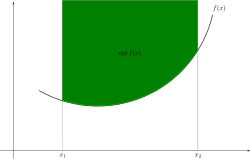Cotorsion group
Jump to navigation
Jump to search

In mathematics, the epigraph of a function f : Rn→R is the set of points lying on or above its graph:
The strict epigraph is the epigraph with the graph itself removed:
The same definitions are valid for a function that takes values in R ∪ ∞. In this case, the epigraph is empty if and only if f is identically equal to infinity.
Similarly, the set of points on or below the function is its hypograph.
Properties
A function is convex if and only if its epigraph is a convex set. The epigraph of a real affine function g : Rn→R is a halfspace in Rn+1.
A function is lower semicontinuous if and only if its epigraph is closed.
References
- Rockafellar, Ralph Tyrell (1996), Convex Analysis, Princeton University Press, Princeton, NJ. ISBN 0-691-01586-4.